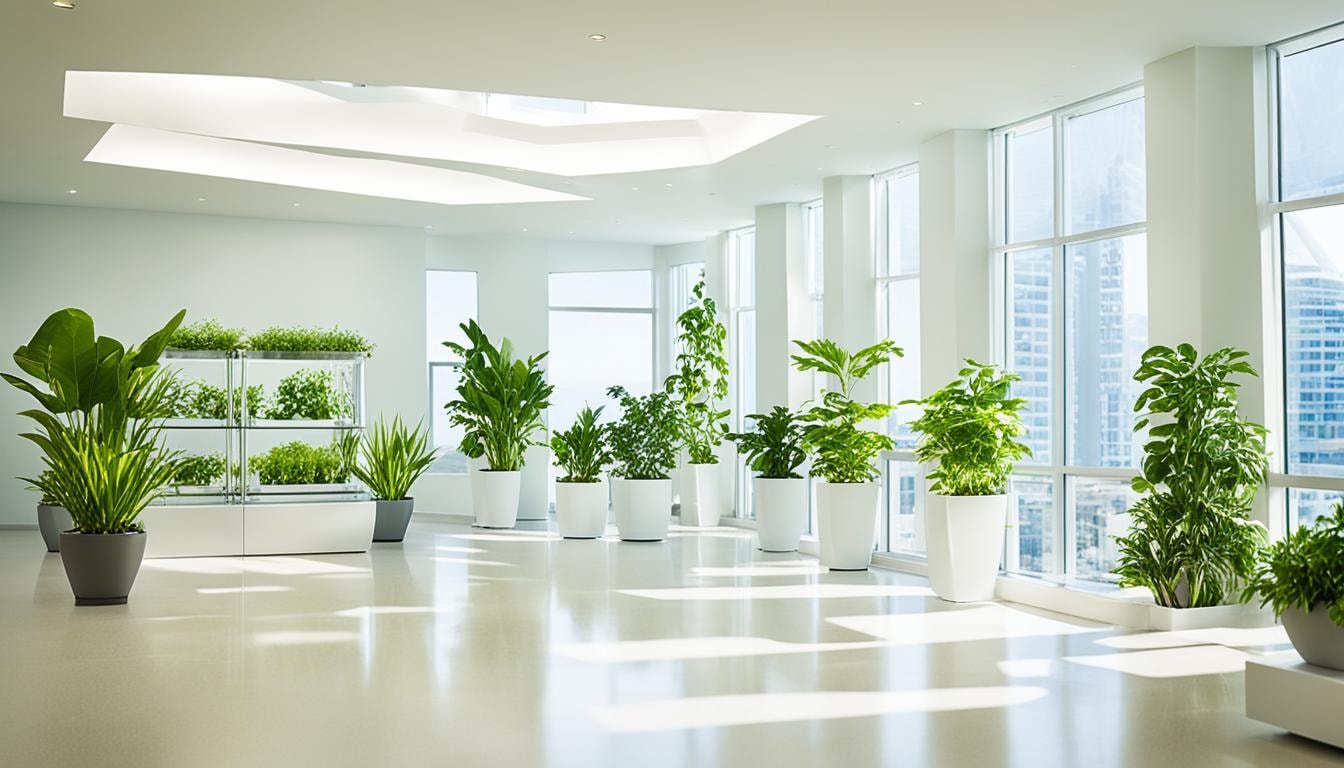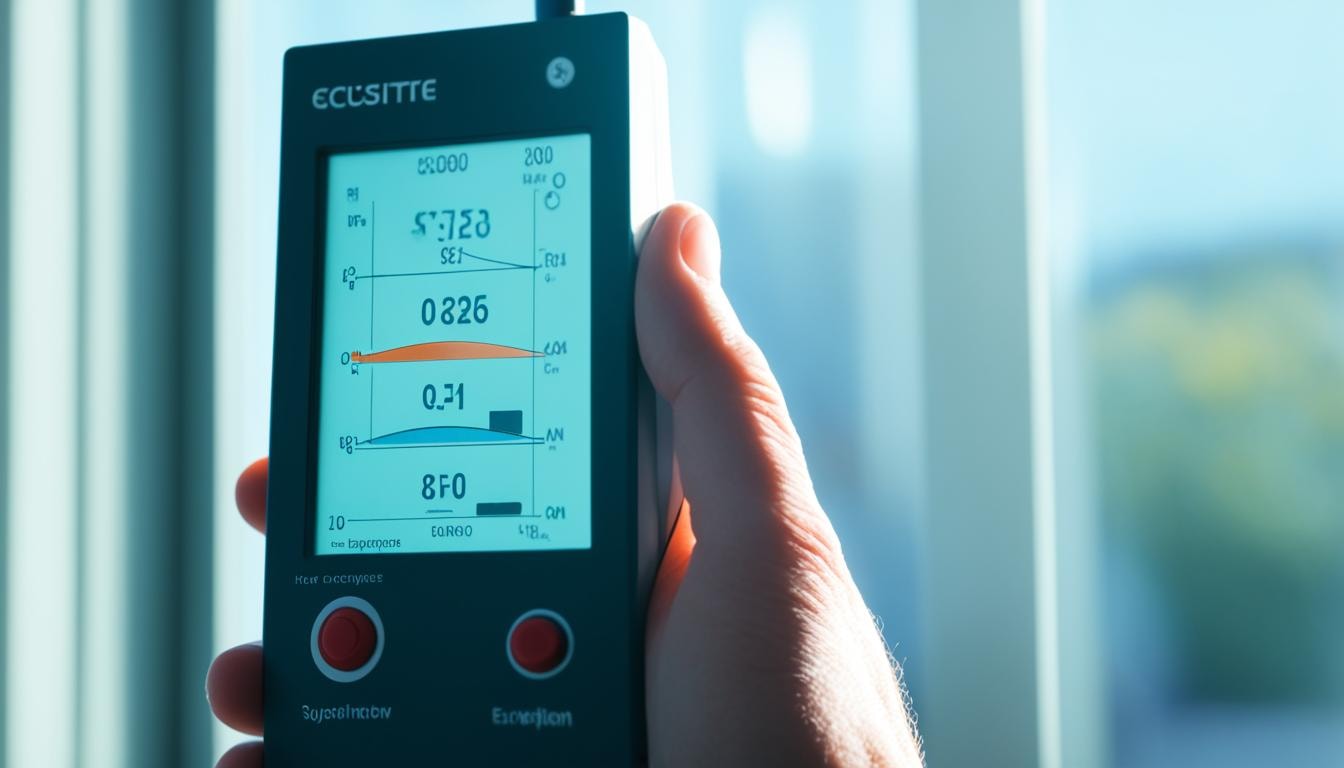Air Quality Testing Near You
Can’t find what you are looking for?
How It Works
-
Answer a few questions about your home project.
-
Within seconds, get matched with top-rated local pros.
-
Compare quotes and choose the best pro for the job.
Air Quality Testing In Your Area
Air Quality Testing
Did you know the air inside your home or office might be 100 times dirtier than outside? This hidden danger can hurt your health and well-being. It can cause breathing problems, allergies, and even long-term health issues. But, you can take steps to make your indoor air cleaner and healthier.

Key Takeaways
- Indoor air can be up to 100 times more polluted than outdoor air.
- Experienced inspectors use cutting-edge technology to identify and measure air pollutants.
- Improved indoor air quality can lead to better respiratory health and a healthier living environment.
The Importance of Clean Indoor Air
Americans spend about 90% of their time indoors, says the U.S. Environmental Protection Agency. This means the air inside is key to our health and well-being. Sadly, indoor air is often more polluted than outside air, with up to five times more contaminants inside homes and buildings.
Health Risks of Poor Air Quality
Indoor air has invisible pollutants like mold, dust, dust mites, and even carbon dioxide and monoxide. These can cause serious health problems. For example, the World Health Organization says 3.8 million people die each year from illnesses caused by bad indoor air, mainly from dirty cookstoves and fuel.
Invisible Threats Lurking Indoors
Indoor air pollutants are hard to spot. Radon, a gas you can’t see or smell, is harmful and causes lung cancer. It leads to about 21,000 U.S. deaths a year, the EPA says. Other threats like VOCs and asbestos are also in our homes and workplaces, hurting our air quality and health.

Keeping indoor air clean is crucial for our health and well-being. It affects our breathing, thinking, and overall health. By knowing how important clean air is, we can make our homes and workplaces healthier. This way, we can breathe easier.
What is Air Quality Testing?
Air quality testing checks the air in places like homes, offices, or buildings. It uses special tools to find pollutants like VOCs, dust, and harmful gases. This helps us know if the air is safe and healthy for people living or working there.
Tests find many pollutants in the air at home. These include things like dust, chemicals, and gases. They look at dust, paint, and air samples to check the air quality.
It’s a good idea to test the air quality every 3-5 years. This is especially true for people with allergies or breathing problems. Catching the symptoms of air quality issues early can prevent health problems like headaches and sneezing.
The EPA and OSHA set rules for testing air to determine its quality. They make sure the air is safe from dangers like radon and carbon monoxide. These are harmful substances that need special attention.

Knowing the air quality helps keep places safe and healthy. It helps find and reduce pollutants like mold and dust mites. Testing the air is key to a healthy indoor space for everyone.
Common Indoor Air Pollutants
Our homes and workplaces can have an exposure to many pollutants that affect our health. These include volatile organic compounds (VOCs), dust, and allergens.
Volatile Organic Compounds (VOCs)
VOCs are gases from things like cleaning products, building materials, and furniture. Being around them too much can hurt our health. It can cause breathing problems and harm our liver and kidneys.
Using products with low VOCs and keeping good air flow can help. This makes our indoor air cleaner.
Particulate Matter and Allergens
Things like dust, pet hair, and mold can make indoor air bad. They can make allergies worse and make breathing hard. Keeping things clean, using air filters, and controlling moisture can help.
It’s important to check and fix these air pollutants to stay healthy. Knowing what causes them and acting early can make a big difference. This way, we can breathe better and stay healthy.
When Should You Test Your Indoor Air?
Keeping our indoor air clean is key for our health. We can’t see or smell the harmful stuff in our homes. But, it can hurt our breathing and life quality. Testing our air often helps find problems early and keeps us safe and healthy.
Signs of Poor Air Quality
Some signs show we need to check our home air quality. If you or your family has ongoing breathing problems or health issues, check your air. Seeing mold or other dirt, bad smells, lots of moisture on walls, or feeling your home is too stuffy are also warnings.
- Persistent respiratory problems, such as asthma, allergies, or frequent sinus infections
- Unexplained health issues, including headaches, fatigue, or dizziness
- Visible signs of mold, dust, or other contaminants
- Musty odors or excessive condensation on walls
- A general feeling of poor air quality or stuffiness in the indoor environment
Testing your air early can find the main cause of problems. It helps you find ways to make your air cleaner for your family.
Preparing for Air Quality Testing
Before starting air quality testing, get your indoor space ready. Look for pollution sources like cleaning products, building materials, or bad HVAC or heating systems. This helps experts test the air quality and give better advice for making it better.
First, check your home or office carefully. Search for moisture, mold, or other things that can make the air bad. You might want to get some tools to help you prepare:
- Radon test or radon detector: Finds radon gas from rocks and soil breaking down.
- Carbon monoxide detector: Finds carbon monoxide gas, which can cause confusion, dizziness, and headaches.
- Mold test types: Swabs, tape strips, air pumps, and petri dish tests find mold in your place.
- Air quality monitor: The Temptop M10 Air Quality Monitor, priced at .99, tracks dust, VOCs, and formaldehyde in the air.
- Mold test kit: The Seeml Labs DIY Mold 3 Test Kit, priced at .50, gives accurate mold test results from a lab.
By doing these steps, you make it easier for air quality testing experts. This way, the results will show the real air quality in your home or office.
The Air Quality Testing Process
Keeping the air inside clean is key for a healthy home. The first step in testing air quality is a detailed look around the house. Experts check for things like mold, water damage, or chemicals.
Visual Inspection
Experts look for signs that could harm air quality during the visual check. They search for things like:
- Visible mold or mildew growth
- Water leaks or moisture problems
- Dusty or dirty HVAC systems
- Improperly stored household chemicals
- Poor ventilation or air circulation
This check-up gives important clues about the air inside. It helps decide what to do next in testing air quality.
Air Sampling and Analysis
After checking visually, air samples are taken from different spots. These samples are then checked with special tools. They look for things like VOCs, dust, and harmful gases.
This mix of visual checks and air sampling gives a full picture of the air inside. It helps find out what pollutants are there and how much. This info is key to making the air better and keeping homes healthy.
Understanding Your Air Quality Report
The air quality report from professional testing is key to knowing health risks from indoor air. It lists the pollutants and their levels in your indoor air.
This report gives you a clear view of the air you breathe. It shows the hidden dangers in your indoor spaces. By looking at the test results, you can see how clean or dirty your air is. This helps you make changes to improve it.
The report talks aboutvolatile organic compounds (VOCs),particulate mattercontamination, and othercontaminants. Thesepollutantscan cause health problems, like breathing issues or worse.
It’s important to understand the report to make your air cleaner. By looking at it, you can see what pollutants need action. This lets you focus on making your air healthier.
The air quality report is key for better air in your home, office, or other places. By reading and understanding it, you can protect your health. You can make your space safer and more comfortable.
Improving Indoor Air Quality
Having clean air inside is key for a healthy life and work. Experts use air quality tests to suggest ways to make the air better. They recommend better ventilation and air purifiers to fight pollution and make spaces safer.
Ventilation and Air Purification
Good airflow is vital for clean air inside. Systems that move air all over the house can cut down on harmful pollutants like radon. Changing filters often and making sure systems work right helps a lot.
Air purifiers also help by removing dust, allergens, and harmful gases. They are great for reducing air pollution from cooking, which can hurt lungs.
Controlling Sources of Pollution
It’s important to tackle the main causes of bad air inside. This might mean changing building materials or cleaning products. For example, radon gas is harmful and should be tested for. Also, keeping homes smoke-free and avoiding candles or fireplaces helps a lot.
Using a mix of better airflow, purifiers, and controlling pollution sources makes for a healthier space. Regular upkeep, like changing filters and using systems right, keeps the air clean over time.
Hiring Professional Air Quality Testers
Hiring experts to check your home air quality tests is key. They know how to test and improve the air inside. They have the right skills and papers to do this job well.
Qualifications and Certifications
Find testers with big names in the field backing them. This shows they know their stuff and care about clean air. Look for these qualifications:
- Certified Indoor Air Quality Professional (CIAQP) certification
- Accreditation from the American Industrial Hygiene Association (AIHA)
- Certification from the National Environmental Health Association (NEHA)
- Experience in air quality checks and fixing problems
These pros can spot dangers like harmful chemicals, dust, and allergens. They use their skills and tools to find these issues. This means you get clear results to help you make smart choices for cleaner air.
Choosing skilled and certified testers means your air quality worries are in good hands. You’ll breathe easier and stay healthier at home or work.
Maintaining Healthy Indoor Air
Keeping the air inside your home or office clean is a big job. It needs careful watching, regular checks, and long-term fixes. By tackling air quality problems early, you make a safe and comfy place for everyone.
Testing your indoor air often is key to finding hidden dangers. Look for things like volatile organic compounds (VOCs), dust, and other bad stuff. Experts say to test your air once a year, or more if you notice bad smells, more allergies, or feeling stuffy.
Keeping your home’s air vents working right is important. Make sure your HVAC is running well, change filters often, and keep air flowing. Open windows and use fans in the kitchen and bathroom to help air out. Think about getting air purifiers to make your air even cleaner.
It’s also vital to control indoor pollution sources. Keep your home clean to reduce dust and smells. Check for mold or moisture that can make air quality bad. Avoid things that give off bad smells, like new furniture or building materials.
By being careful and active about your indoor air, you make a healthier place for you and your family. Testing, good air flow, and fighting pollution are key to clean indoor air.
Breathe Easier with FindPros
Are you concerned about the air quality in your home or office? Don’t worry, FindPros has got you covered! Simply fill out our quick survey about your home improvement project, and we’ll match you with top-rated local professionals who specialize in indoor air quality testing and remediation. Get the best pricing when multiple pros compete for your job, and find the perfect fit for your needs. With FindPros, you can breathe easier knowing that your indoor air is clean and healthy. Get started now and take the first step towards a healthier living environment!
Conclusion
Air quality testing is key for your health, safety, and comfort. Working withexperienced proshelps spot and fix air quality problems. This way, you can make your living or work space healthier and more enjoyable.
The COVID-19 pandemic made us realize how vital good air quality is. Since we spend most of our time inside, it’s crucial to test and improve poor indoor air quality. This helps keep you healthy, boosts your work, and makes your space more comfy for everyone.
For homeowners, business owners, or those in charge of schools, testing air quality is a must. By acting early and getting help from experts, you can make sure the air is clean and safe. Don’t wait for air quality issues to get worse – act now and breathe easily.
Frequently Asked Questions (Air Quality Testing)
MOST POPULAR CITIES
Browse by State- Alameda
- Costa Mesa
- Laguna Beach
- Orange
- Alhambra
- Culver City
- Lancaster
- Oroville
- Anaheim
- Daly City
- Livermore
- Oxnard
- Antioch
- Davis
- Lodi
- Pacific Grove
- Arcadia
- Downey
- Lompoc
- Palm Springs
- Bakersfield
- El Centro
- Long Beach
- Palmdale
- Barstow
- El Cerrito
- Los Angeles
- Palo Alto
- Belmont
- El Monte
- Malibu
- Pasadena
- Berkeley
- Escondido
- Martinez
- Petaluma
- Beverly Hills
- Eureka
- Marysville
- Pomona
- Brea
- Fairfield
- Menlo Park
- Port Hueneme
- Buena Park
- Fontana
- Merced
- Rancho Cucamonga
- Burbank
- Fremont
- Modesto
- Red Bluff
- Calexico
- Fresno
- Monterey
- Redding
- Calistoga
- Fullerton
- Mountain View
- Redlands
- Carlsbad
- Garden Grove
- Napa
- Redondo Beach
- Carmel
- Glendale
- Needles
- Redwood City
- Chico
- Hayward
- Newport Beach
- Richmond
- Chula Vista
- Hollywood
- Norwalk
- Riverside
- Claremont
- Huntington Beach
- Novato
- Roseville
- Compton
- Indio
- Oakland
- Sacramento
- Concord
- Inglewood
- Oceanside
- Salinas
- Corona
- Irvine
- Ojai
- San Bernardino
- Coronado
- La Habra
- Ontario
- San Clemente